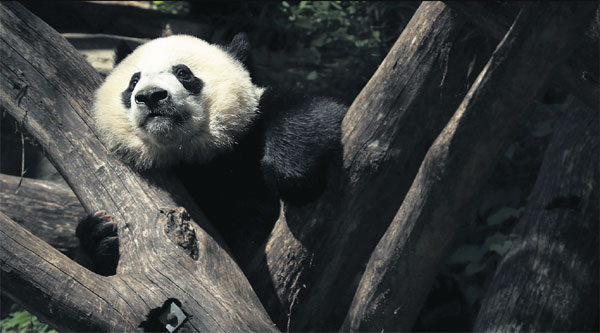Panda love? It's there in black and white
|
GIANT PANDAS are some of the world's most vulnerable and rare creatures. Photos Provided to China Daily |
The gift to the United States in 1972 of two rare and very cute animals began the 'year of the panda' and a continuing fascination with the lovable animals
On a fine April day, 19-month-old giant panda cub Bei Bei is climbing a tree at the National Zoo in Washington DC, in the United States, drawing laughter from the crowds.
"I started coming here way back to the 1970s when China gifted two (giant) pandas to Washington," says Stephanie Smith, her gray hair held in place by a panda pin. She is overjoyed by the antics of Bei Bei at the giant panda house.
Smith is just one of the 2 million fans who visit Washington to see giant pandas every year.
"They are just part of Washington, like our first family," says Smith. "They are such peaceful, wise creatures."
It was also an April day 45 years ago when Ling Ling and Hsing Hsing - carefully selected and given by the Chinese government as a gift to commemorate the groundbreaking handshakes between leaders from China and the United States that year - arrived in Washington, welcomed in the rain by around 8,000 onlookers.
It was the first time that the Chinese government had given giant pandas as a gift to a Western country. The New York Times made it front page news, saying that "zoo directors are bringing every kind of pressure to get one of the furry clowns with the black-patched white bodies and the black-ringed eyes."
The debut of Ling Ling and Hsing Hsing at the National Zoo attracted more than 20,000 people from far and wide, and the number of visitors for the first month was as many as 110,000, arousing not only panda mania across the country but also interest in China itself among the American people.
The year 1972 was "the year of the panda" in the United States, with "panda diplomacy" bringing closer the peoples from both sides of the Pacific Ocean. For four decades since then, giant pandas have remained a symbol of friendship between the two countries.
US-born giant panda Bao Bao met the public for the first time in Chengdu in Southwest China's Sichuan province on March 24, a month after the 3-year-old female flew back to her home country on a charter flight from Washington.
US Charge d'Affaires David H. Rank told Xinhua after watching Bao Bao settling into her new home that he thought the day was highly significant to relations between the US and China, praising the cooperation between the two countries on scientific research and protection of endangered wildlife.
During her 16-hour trip to Chengdu, Bao Bao was accompanied by her US keeper Marty Dearie and Dr Katharine Hope to ensure a smooth flight. She was greeted by Chinese experts immediately after landing at Chengdu Shuangliu International Airport on Feb 22.
"Upon arrival at the Dujiangyan panda base, Bao Bao walked into her new enclosure within one minute when her new keeper opened her travel crate door. She immediately started exploring and was very relaxed," Dearie wrote on the website of the US National Zoo.
"Hopefully, in a few years our colleagues in China will share happy news with us that Bao Bao has become a mom," Dearie wrote.
Bao Bao, whose name means "precious" or "treasure" in Chinese, has been dubbed by fans as the world's cutest giant panda. She was the first female born at the US National Zoo and has won the hearts of numerous Americans since her birth. Her parents Mei Xiang and Tian Tian, moved to the US zoo in 2000 under a collaboration agreement between China and the United States.
Since 1984, China stopped giving giant pandas as gifts abroad and began to offer them only on a 10-year loan. According to the agreement, panda cubs born in the United States to parents on loan from China must be returned to China before they are 4 years old.
China's Ambassador to the United States Cui Tiankai told The Washington Post: "It's very difficult for giant pandas to breed naturally. Chinese and Americans have been working on breeding them through artificial insemination".
The US State Department has described giant pandas as "a tangible and fluffy manifestation of cooperation between the United States and China".
The animals are clearly envoys of China-US friendship that have stood the test of time. Over the past four decades, wherever pandas have gone they have taken love and joy.
A recent example was with Bao Bao. Traveling with her were love and caring thoughts from the American people.
"You will be forever with me Princess Pinky. I am so sad," said Dawn LaValley, describing herself as Bao Bao's auntie. She sent her a letter recently, along with a photo of a new tattoo on her arm, which is a portrait of Bao Bao. "I feel so connected with you that I have a tattoo on my left arm of you."
The Chinese embassy in Washington recently received a letter and two drawings from the Foltz family, saying that they were writing "in great appreciation" for sharing China's natural treasure, the giant panda, with people of the US.
Giant pandas are some of the world's most vulnerable and rare creatures, with a known population of only 1,600, mostly in China. The United States has the most outside China, with 12 living in four cities - Washington, Atlanta, San Diego and Memphis.
Xinhua



















